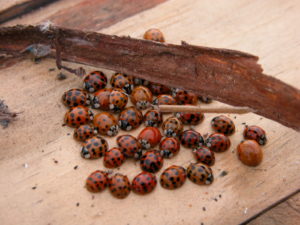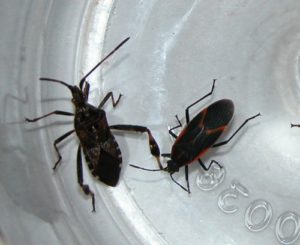
Multicolored Asian ladybeetles search for places to spend the winter and often congregate in protected places. Photo: Linda Williams, WI DNR
This fall, some areas of the state saw large numbers of ladybugs (specifically multicolored Asian ladybeetles) congregating as fall gave way to colder temperatures. Box elder bugs, leaf-footed bugs (or western conifer seed bugs), and brown marmorated stink bugs were also seen congregating this fall in areas of the state where they have been found before. These insects are attracted to homes and will attempt to find a way inside to spend the winter in a protected place. The urge to look for an overwintering spot is triggered by the first hard frosts and freezes of the season, but this year we had a fabulous warm-up after a cold spell which allowed the insects ample time to congregate on houses.

A Western conifer seed bug (sometimes called leaf footed bugs) on the left, and boxelder bug on the right. These two species also congregate in the fall as they look for warm protected places to spend the winter. Photo: Linda Williams, WI DNR
If you’re having problems with these insects invading your house you can try to “build them out”. Spraying the exterior of your house with appropriate pesticides to keep them out (which will repel all insects for a time) works well but it’s recommended this is completed by the last week of September or first week of October. UW Extension offers a fact sheet that gives suggestions for keeping ladybugs out of your home. When I get calls about ladybugs or box elder bugs inside the home, I recommend vacuuming the critters up, but always avoid squishing, since squishing them will stain whatever they are crushed on. Be sure to empty vacuum bags that have ladybugs in them as the ladybugs will start to smell after they die.
It’s not unusual for me to hear of folks mixing up multicolored Asian ladybeetles with Japanese beetles … they’re two different critters. And, yes, multicolored Asian ladybeetles are indeed ladybugs. Both exotic and native ladybugs feed on aphids and scales which means that they’re beneficial, but only the exotic ones will try to spend the winter in your house or garage.
Written by: Linda Williams, forest health specialist, Woodruff. Linda.Williams@wisconsin.gov; 715-356-5211 x232
